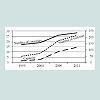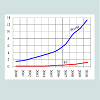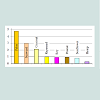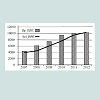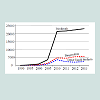Journal of Microbiology & Microbial Technology
Download PDF
Research Article
*Address for Correspondence: Hrvoje Glavaš, Faculty of Electrical Engineering, Computer Science and Information Technology Osijek, Josip Juraj Strossmayer University of Osijek, Kneza Trpimira 2B, 31000 Osijek, Republic of Croatia, Tel: ++385-31-224-600; Fax: ++385-31-224-605; E-mail: hrvoje.glavas@etfos.hr
Citation: Ivanović M, Glavaš H, Gantner R. Biofuels in Croatia. J Microbiol Microb Technol 2016;1(2): 5.
Copyright © 2016 Ivanović M, et al. This is an open access article distributed under the Creative Commons Attribution License, which permits unrestricted use, distribution, and reproduction in any medium, provided the original work is properly cited.
Journal of Microbiology & Microbial Technology | Volume: 1, Issue: 2
Submission: 05 November, 2016 | Accepted: 20 December, 2016 | Published: 27 December, 2016
Bioethanol is used in the chemical industry and as a motor fuel (alternative to gasoline). In the US, ethanol mixture (produced from corn) makes up about 9% of the total annual sales of gasoline. Most of today’s US car can drive on a mixture of gasoline with 15% of bioethanol. In Brazil (which is the leading country in the world in the production and use of ethanol for vehicles) bioethanol is produced from sugar cane; 15% of Brazil’s vehicles can run on pure ethanol, and the other using a 20% mixture with gasoline [11].
The advantages of biodiesel compared to fossil fuel are:
Biogas production in Croatia began in 2004 and since than is being used for the production of electricity; in the late 2015 Croatia had a total of 20 power plants on biogas; one landfill gas capacity of 3 MW, one power plant on gas from waste water treatment capacity of 2.5 MWh and 18 power plants on biogas from livestock manure with total output of 21.9 MWh (Figure 9) [21].
Biofuels in Croatia
Milan Ivanović1, Hrvoje Glavaš2* and Ranko Gantner3
- 1Panon Think tank for strategic studies, Osijek, Republic of Croatia
- 2Faculty of Electrical engineering, Josip Juraj Strossmayer University of Osijek, Osijek, Republic of Croatia
- 3Faculty of Agriculture, Josip Juraj Strossmayer University of Osijek, Osijek, Republic of Croatia
*Address for Correspondence: Hrvoje Glavaš, Faculty of Electrical Engineering, Computer Science and Information Technology Osijek, Josip Juraj Strossmayer University of Osijek, Kneza Trpimira 2B, 31000 Osijek, Republic of Croatia, Tel: ++385-31-224-600; Fax: ++385-31-224-605; E-mail: hrvoje.glavas@etfos.hr
Citation: Ivanović M, Glavaš H, Gantner R. Biofuels in Croatia. J Microbiol Microb Technol 2016;1(2): 5.
Copyright © 2016 Ivanović M, et al. This is an open access article distributed under the Creative Commons Attribution License, which permits unrestricted use, distribution, and reproduction in any medium, provided the original work is properly cited.
Journal of Microbiology & Microbial Technology | Volume: 1, Issue: 2
Submission: 05 November, 2016 | Accepted: 20 December, 2016 | Published: 27 December, 2016
Abstract
European Commission has adopted a series of documents in order to achieve energy policy targets. One of them is Directive 2009/28/EC which promotes the use of renewable energy in transportation. The Directive sets targets for Member States. According to the provisions of Article 11 of the Law on Biofuels for Transport, each county of the Republic of Croatia is obliged to develop a program to encourage the production and use of biofuels in transport and establish the policy of increased production and use of biofuels in transport in the county in accordance with the National Action Plan. The program is a three-year planning document that is being proposed by the county executive authority and adopted by the representative body of the county. The paper is result of study of the implementation of biofuels in Republic of Croatia.Keywords
Biofuel; EU; Croatia; EnergyIntroduction
Reduction of energy consumption through actions to increase energy efficiency, and increase the consumption of renewable energy sources (RES) are the fundamental guidelines of the National Programme of measures to reduce greenhouse gas emissions, and the fulfillment of the objectives of the UN Framework Convention on Climate Change and the implementation of the agreement [1]. These measures, at the same time play a significant role in increasing the security of energy supply, and stimulate local economic development. Biofuels as a renewable source of energy are of particular interest because they can replace fossil fuels for transport, which in total energy consumption accounted for more than 30% and represent a significant potential to reduce the sources of greenhouse gas emissions.In the last ten years the European Commission has adopted a series of documents governing the sustainable system of measures with which the Member States will encourage the jointly stated goals. Directive 2009/28/EC on the promotion of the use of energy from renewable sources define the objectives and obligations of the countries in the promotion and use of renewable energy in final consumption of electricity, heat and fuel for transportation [2]. The Directive sets Member States targets for share of energy from renewable sources in the total energy demand for transport of 10% by 2020. Guidelines from the Directive are transposed into national legislation of EU member states by the end of 2010.
The production and use of biofuels vary from country to country, but governments have adopted programs that would target of 10% of fossil fuels replaced by biofuels within 10-20 years. The countries have focused mainly on liquid biofuels (ethanol and biodiesel), partly due to replacements of conventional transportation without major changes in technology, but there are those countries that aspire other technological and technical solutions [3].
CO2 emissions in the EU were increased by 32% in the period 1990 - 2005. EU strategy determined that states should ensure emission reduction of vehicles in traffic to a minimum of 120 g CO2/km by 2012. This should reduce emissions by 19% and set the EU as leaders efficient vehicles. For an average of 120 g CO2/km for newly manufactured passenger cars there is needed additional reduction for 10 g CO2/km to achieve the objective, what will be realized through technical improvements. For 2020, the EU said, the average emissions are assumed to be 95 g CO2/km. By 2025 plan is to reduce emissions to 70 g CO2/km [4]. The EU strives to be the world leader in the successful replacement of fossil fuels with biofuels [5,6].
The Legislation on Biofuels
The National Action Plan to encourage the production and use of biofuels in transport for the period 2011 – 2020 is a basic operational framework to encourage the production and use of biofuels in transport, and is made pursuant to the Act on Biofuels for Transport in accordance with the Energy Strategy Development, the Strategy for Sustainable Development, Strategy for Agriculture and Fisheries of the Republic of Croatia and the National Forest Strategy as well as Directive 2009/28/EC which establishes a policy of increased production and use of biofuels in transport in Croatia [1,2,7-10].The National Action Plan contains a presentation and evaluation of the situation on the fuel market for transport and air protection, comparative analysis, long-term goals, including placing biofuels on the market, measures to stimulate increased production and use of biofuels in transport and defines the national goal. The national target for placement of biofuels on the market, the minimum planned target for placement of biofuels on the market for transportation purposes in the Republic of Croatia, is determined as a percentage of biofuels on the market in one year on the basis of calculation of the energy content of all diesel and gasoline for transport purposes in the market [1].
Program to encourage the production and use of biofuels in the County’s transport is a planning document that is adopted for a period of three years (in accordance with the National Action Plan). The County’s Program contains a presentation and evaluation of the situation and the needs of the market in fuel for transport in the county, comparative analysis, long-term goals and measures to stimulate increased production and use of biofuels in transport. The County Program is being proposed by the executive authority, and the representative body of the County approves the Program, which should be submitted to the Ministry of Economy by the end of September of the current year [1]. There are 20 counties in Croatia, and each one is a unit of local and regional administration which has a certain influence to the economic and other events.
Main Characteristics of Biofuels
Biofuels are considered renewable. They have a potential to reduce the production of carbon dioxide. This is based on the fact that the plants (from which the biofuels are being produced) absorb CO2 during the growing season, which will later be released by burning biofuels, thus bringing the CO2 balance to zero. Products which are considered as biofuels are [9]:•Bioethanol: Ethanol produced from biomass and/or from the biodegradable fraction of waste
•Biodiesel: Methyl ester of fatty acids (FAME) produced from vegetable oil or animal fat
•Biogas: Produced from biomass and/or from the biodegradable fraction of waste
•Biomethanol: Methanol produced from biomass
•Biodimethylether: Dimethylether produced from biomass
•Bio-ETBE (ethyl tert-butyl ether): A fuel produced on the basis of bioethanol. The percentage by volume of bio-ETBE that is calculated as biofuel is 47%
•Bio-MTBE (methyl-tert-butyl-ether): A fuel produced on the basis of biomethanol. The percentage by volume of bio- MTBE that is calculated as biofuel is 36%
•Synthetic biofuels: Synthetic hydrocarbons or mixtures of hydrocarbons, which are produced from biomass
•Biohydrogen: Produced from biomass and/or from the biodegradable fraction of waste
•Pure vegetable oil: Produced from oil plants through pressing or extraction
Nowadays there is practically being used two types of biofuels to drive vehicles: biodiesel and alcohols - alone or as an adjunct to conventional (fossil) fuels. There can be distinguished the biofuels of first, second and third generation and the criteria are: the source material for the production and CO2 emissions. The first generation is produced from sugar, starch, vegetable oils or animal fats, for the production of second generation there are used agricultural and forest waste and the third-generation biofuels are produced from algae. The production of second and third generation biofuels is not yet in wider use because of high production costs [14,15]. It has been established - on the basis of laboratory tests - that algae can produce up to thirty times more energy per hectare of land than the grains such as soybeans.
Bioethanol
Bioethanol is ethanol produced from biomass or the biodegradable fraction of waste, used as biofuel. The most important raw materials for bioethanol production are sugar cane, sugar beet, corn, wheat, sorghum and potatoes. First generation bioethanol is produced from cereal grains (e.g. corn or wheat) and sugar-rich plant parts (sugar beet and cane), and the Second generation bioethanol from various cellulosic materials including the remains of agricultural crops (corn stalks, cereal straw, etc.). Figure 1 shows the possible ethanol production by type of some agricultural resources.Figure 1: Possible annual production of bioethanol by type of raw material (l/ha) [12].
Figures 2 and 3 shows the development of bioethanol production in the world; since 1999, the number of factories (51) has increased to 211, the number of countries in which the products are growing by 17 to 28, and the capacity for production - from 1.7 to 14.7 mil gallons per year (Figure 2). Since the beginning of industrial production of bioethanol (1980) production has increased from 175 million to 13.3 billion gallons (Figure 3).
Figure 2: Capacities for bioethanol production in the world (106 gallons) [12].
Figure 3: The production of bioethanol in the world and the EU (109 gallons) [13].
Biodiesel
Biodiesel is the commercial name for methyl ester with no added mineral fuels. This is a standard non-mineral liquid fuel that is fully biodegradable, non-toxic and reduces harmful gases that produce the greenhouse effect. Harmful emissions of biodiesel are much lower in comparison with diesel fuel. Its use reduces carbon emissions (additionally because oxygen in biodiesel enables more complete combustion CO2) and decreases the sulphate precipitation (biodiesel contains less than 24 ppm sulfur). In biodiesel there no aromatics thus reducing the cancer-causing compounds in the exhausted gases [9]. Figure 4 shows the possible production of biodiesel according to the different types of raw materials.Figure 4: Possible annual production of biodiesel by type of raw material(103 l/ha) [13].
•Ecological: Reduced emissions of gases that cause the greenhouse effect, primarily CO2, CO, SO2; No soot, Benzene, Toluene in the exhaust gases; Biodiesel is biodegradable and non-toxic; Accidental spills do not pose an environmental risk.
•Energy: Basic raw materials are renewable; Reducing the need for imports of fossil diesel fuel.
•Technical: Higher content of oxygen in biodiesel enables more complete combustion; Extends engine life; Do not require any modifications to the engine and fuel injection system; The use of biodiesel does not require changes to existing transport and storage systems.
•Economics: Lower the price of biodiesel compared to fossil diesel; Increased employment of domestic industrial and agricultural production; Reduce dependence on imports of crude oil and petroleum products.
It should be emphasized that the by-product of rapeseedbiodiesel is a rapeseed cake (meal), a valuable protein-rich feed used in livestock feeding, which also prevents the mad cow disease (if used to replace the dangerous protein concentrates of animal origin). Another by-product is glycerin used in industry. Figure 5 shows the production of biodiesel in the world and the EU; Production is growing exponentially; 213 mil in 2000 to 5.3 billion gallons in 2012.
Figure 5: Biodiesel production in the world and the EU (106 gallons) [15].
Biogas
Biogas is a fuel gas produced from biomass. Biogas is obtained by anaerobic decomposition of biodegradable materials; the resulting gas is composed of approximately 60% Methane (CH4), 35% Carbon dioxide (CO2), and about 5% of a mixture of Hydrogen (H2), Nitrogen (N2), Ammonia (NH3), Hydrogen sulfide (H2S), Carbon monoxide (CO), Oxygen (O2) and Water vapor. The most important fuel component of biogas is methane. Methane formation is a biological process that naturally occurs in the decomposition of organic substances in wet conditions without the presence of oxygen, in the presence of metabolically active microorganisms - methanogenic bacteria [16,17]. Biogas can be produced from almost all organic materials, primarily agricultural origin, and other sources of organic matter e.g. wastewater treatment plants.The conversion of biomass into biogas by anaerobic fermentation has several advantages over other methods of disposal of organic waste [17]:
•Lower sludge production compared to aerobic techniques care,
•Successful disposal of wet waste to 40% dry matter,
•Successful removal of pathogens,
•Minimum emissions of odors,
•Resulting slurry (digestate) is improved fertilizer in terms of availability of plant nutrients and improved rheological properties, ie., real savings on the purchase and use offertilizers,
•A high degree of compliance with a number of national and EU regulations for waste disposal (e.g. EU Nitrates Directive),
•CO2 neutral source of energy.
Options for biogas are numerous; most often used for energy, but also in the chemical industry for the preparation of carbon black, acetylene, formaldehyde, and the production of dry ice and methane chlorination products are methylene, chloroform, and other compounds which have a wide application [18]. The energetic use of biogas includes the direct combustion to produce heat, to generate electricity or to run motor vehicles.
The use of biogas in the transport sector has a great potential. Biomethane as a motor fuel is already in use in Sweden, Germany and Switzerland. The number of private vehicles, public transportation vehicles and trucks that use gas fuel is significantly increasing. Biogas in vehicles can be used (by compressing to the bottle) in the same way as LPG (propan_butan) or natural gas. A growing number of European cities replace diesel fuel with biomethane in city buses [15]. Heavy duty vehicles can be converted to the solely gas powered, and in some cases can be used “dual fuel” engines. Biomethane vehicles have significant advantages compared to gasoline or diesel. Emissions of CO2, NOx, NMHC and particulate matter and soot are significantly lower than in the case of engines using fossil fuels. When compared to other biofuels, biomethane is considered to have the greatest potential in use as a fuel for vehicles, and it appears the best for the environment. Figure 6 shows the rapid growth in the number of biogas plants and installed electrical power plants using biogas in the world and Figure 7 shows growth of the installed capacities to biofuel production in the EU 28. Cattle excrements (manure) are an important by-product of livestock production, but also become the technological problem of waste on farms, because its accumulation leads to unpleasant odors and creates chemical and toxic substances. As the cattle manure potentially carries the causes of various diseases, it is of great importance from the epizootic and epidemiological point of view to digest it in the biogas. Manure contains important secondary nutrients and micro-nutrients and it is irreplaceable in agriculture; at the same time, manure as organic mass has a very large potential for energy production. The composition of manure depends on the type of farm animals, feeding, keeping conditions, and the type of bedding and intensity of production, and thus the chemical composition and use value different.
Figure 6: Number of biogas plants (BrPE) and their electrical power (Sel BPE) in the world (MW) [12].
Figure 7: Installed capacities to biofuel production in the EU 28 [20].
The Energy Strategy of the Republic of Croatia has set up a goal for the 2020 year, to use at least 20 % of the total livestock excrements for the bioenergy purpose and in that way to produce about 100 million m3 of biogas, or about 2.6 PJ of energy [7].
In addition to animal manures, there are other substrates being used for the digestion processes. They generally belong to the so called energy crops which are crops produced exclusively for energy production. Energy crops consist mainly of annual plants (species of grass, corn, beet, etc.), and woody crops (willow, poplar). It is very important that the woody species have to be processed before use in anaerobic digestion, to remove the lignin, but this technology is still in development. Other types of energy crops are crops that are planted between the main crops. Other crops that can be used as intercrops are: clover, peas or beans, winter wheat (silage from whole plant), sweet sorghum and Sudan grass. The main substrates are still excrements of domestic animals (of livestock), agricultural secondary products (from farming), organic residues from trade, industry and catering industry and municipal waste.
Nitrates Directive
Nitrates Directive is a European Union regulation that relates to the protection of water against pollution by nitrates from agricultural sources. In Article 2c Reads: “The term means a pollution discharge, directly or indirectly, of nitrogen compounds from agricultural sources into the aquatic environment, which resulted in the creation of a risk to human health, harm to aquatic ecosystems”. In Annex II of the Code of Good Agricultural Practice p 5 stands out: “it is necessary to provide the capacity and construction of tanks for manure, so as to prevent leakage and seepage into groundwater, liquid contained in manure (slurry)”. According to the provisions of the Nitrates Directive, EU member states should identify waters affected by agricultural practices, mark areas vulnerable to pollution by nitrates, and limit the application of nitrogen fertilizer, and to design and implement operational programs in pollution prevention [19]. In Croatia, in this sense, the most important for farmers Ordinance on good agricultural practice is the use of fertilizers, which entered into force on the date of Croatian accession to the EU.Capacities, Production and Use Biofuels in Croatia
Total installed capacities for liquid biofuels production in Croatia for 2010 were for 64,000 tons per year of biodiesel. In 2010, there were produced 13,841 tons of biodiesel out of which 24 percent ended up at the domestic market. About 3 percent of the total amount originated from collected waste cooking oil. In 2014 there were produced 34,700 tons out of which 96 percent ended up at the domestic market. Figure 8 shows installed capacities for biodiesel production in the Croatia.Figure 8: Installed capacities to biodiesel production in the Croatia (103 t) [20].
Figure 9: Primary production (and consumption) of biogas in the Croatia (Thousand tonnes of oil equivalent) [20].
Conclusions
In accordance with the provisions of the Law on Biofuels for Transport, each county in the Republic of Croatia is obliged, in accordance with the National Action Plan, to develop a program to encourage the production and use of biofuels in transport, establishing the policy of encouraging the production and use of biofuels in transport in the county. The program is a three-year planning document that is proposed by the executive body, and adopted by the representative body of the county.The fundamental starting point for the analysis is the current situation in the sectors that use motor fuels in transport, and natural resources for the production of vegetable raw materials that can be used for the production of biofuels. Based on the analysis - starting from the EU obligations - there are defined the long-term and short-term objectives of the Program for the stimulation of biofuelsproduction and use.
References
- Ministry of Economy of Croatia (2010) The national action plan to encourage the production and use of biofuels in transport for the period 2011 - 2020.
- European Parliament and the Council of the European Union (2009) Directive 2009/28/EC of the European parliament and of the council: on promoting the use of energy from renewable sources and amending and later repealing Directive 2001/77/EC and 2003/30/EC. Official J Eur Union.
- Andrews SS (2006) Crop residue removal for biomass energy production: effects on soils and recommendations, USDA - Natural Resource Conservation Service, USA.
- 4. http://www.ourclimate.eu/ourclimate/default.aspx.
- Ivanović M (2006) Science and regional energy: research on the development of energy and energy use in Slavonia. Faculty of Electrical Engineering, Josip Juraj Strossmayer University of Osijek, Croatia.
- Ivanović M (2007) European trends in renewable energy sources: II. Professional conference with international participation “Renewable energy in the Republic of Croatia”, Proceedings, pp. 237-247.
- The Croatian Parliament (2009) Act on biofuels for Transport, NN 65/09, 145/10, 26/11,144/12, Croatia.
- The Republic of Croatia, Ministry of Economy, Labour and Entrepreneurship (2009) Energy strategy of the Republic of Croatia, Zagreb, Croatia.
- Jaeger KE, Eggert T (2002) Lipases for biotechnology. Curr Opin Biotechnol 13: 390-397.
- Robin W (2008) German biogas market slumps in contrast to Europe. Ecoprog.
- http://ethanolrfa.org/resources/industry/statistics/.
- Austrian Institute for Spatial Planning (ÖIR) (2012) Infrastructure for renewable energies: a factor of local and regional development. European Union, Brussels.
- http://ethanolproducer.com/.
- Nigam PS, Pandey A (2009) Biotechnology for agro-industrial residues utilization: utilisation of agro-residues. Springer Science + Business Media, Germany.
- Sims RE (2004) Bioenergy options for a cleaner environment: in developed and developing countries. Elsevier, UK.
- Deublein D, Steinhauser A (2008) Biogas from waste and renewable resources: an introduction. Wiley Online Library, USA.
- Sagagi B, Garba B, Usman N (2009) Studies on biogas production from fruits and vegetable waste. Bayero J Pure Appl Sci 2: 115-118.
- Polprasert C (1996) Organic waste recycling, Technology and management (2nd edn), John Wiley & Sons, UK, pp. 412.
- EC (2003), Nitrates Directive, 91/676/EEC.
- http://appsso.eurostat.ec.europa.eu/.
- https://www.hera.hr/hr/html/index.html.



